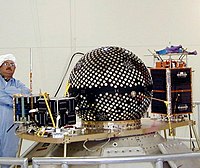HAMSAT also known as HAMSAT INDIA, VU2SAT and VO-52 is a microsatellite weighing 42.5 kilograms (93.7 lb), providing amateur radio satellite communications services for Indian and international amateur radio operators. This satellite carries the in-orbit designation of VO-52, and is an OSCAR series satellite.
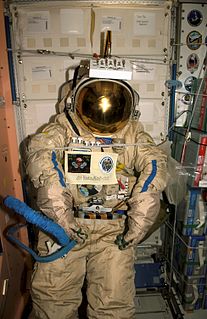
SuitSat was a retired Russian Orlan spacesuit with a radio transmitter mounted on its helmet. SuitSat-1 was deployed in an ephemeral orbit around the Earth on February 3, 2006. The idea for this novel OSCAR satellite was first formally discussed at an AMSAT symposium in October 2004, although the ARISS-Russia team is credited with coming up with the idea as a commemorative gesture for the 175th anniversary of the Moscow State Technical University.
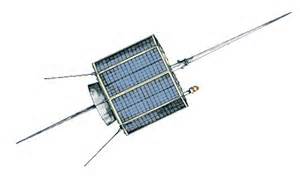
AMSAT-OSCAR 7, or AO-7, is the second Phase 2 amateur radio satellite constructed by the Radio Amateur Satellite Corporation or AMSAT. It was launched into Low Earth Orbit on November 15, 1974 and remained operational until a battery failure in 1981. Then after 21 years of apparent silence, the satellite was heard again on June 21, 2002 – 27 years after launch. At that time the public learned that the satellite had remained intermittently functional and was used surreptitiously for communication by the anticommunist opposition Fighting Solidarity during the martial law in Poland.
Saudi-OSCAR 50 is a Saudi Arabian amateur radio satellite that was launched on 20 December 2002 by the King Abdulaziz City for Science and Technology.
An amateur radio satellite is an artificial satellite built and used by amateur radio operators. It forms part of the Amateur-satellite service. These satellites use amateur radio frequency allocations to facilitate communication between amateur radio stations.

ESTCube-1 is the first Estonian satellite and first satellite in the world to attempt to use an electric solar wind sail (E-sail). It was launched on 7 May 2013 aboard Vega VV02 carrier rocket and successfully deployed into orbit. The CubeSat standard for nanosatellites was followed during the engineering of ESTCube-1, resulting in a 10×10×11.35 cm cube, with a volume of 1 liter and a mass of 1.048 kg.
AO-6 was the first Phase 2 amateur radio satellite (P2-A) launched into Low Earth Orbit. It was also the first satellite constructed by the new AMSAT North America (AMSAT-NA) organization.
OSCAR 5 is an amateur radio satellite that was launched into Low Earth Orbit on 23 January 1970 by a Thor Delta launcher from Vandenberg Air Force Base, Lompoc, California. AO-5 was launched piggyback with ITOS-1.
OSCAR III is the third amateur radio satellite launched by Project OSCAR into Low Earth Orbit. OSCAR 3 was launched March 9, 1965 by a Thor-DM21 Agena D launcher from Vandenberg Air Force Base, Lompoc, California. The satellite, weighing 16.3 kg, was launched piggyback with seven United States Air Force satellites. The satellite employed no attitude control system. OSCAR III linear transponder lasted 18 days. More than 1000 amateurs in 22 countries communicated through the linear transponder. The two beacon transmitters continued operating for several months.
OSCAR IV is the fourth amateur radio satellite launched by Project OSCAR and the first targeted for Geostationary orbit on 12 December 1965. The satellite was launched piggyback with three United States Air Force satellites on a Titan IIIC launch vehicle. The satellite was regular tetrahedron, 48 cm on each side. It had four independent monopole antennas and like OSCAR 3 contained a tracking beacon transmitter and a communications repeater. It was powered by a solar cell array and batteries.

FUNcube-1 is a complete educational single unit CubeSat satellite with the goal of enthusing and educating young people about radio, space, physics and electronics. It is part of a program which aims to launch more of these educational CubeSats. It is the first satellite with outreach as its primary mission.
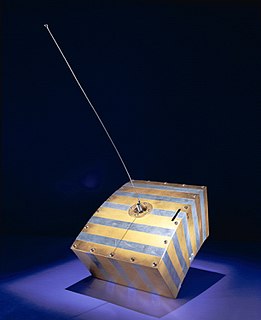
OSCAR I is the first amateur radio satellite launched by Project OSCAR into low Earth orbit. OSCAR I was launched December 12, 1961, by a Thor-DM21 Agena B launcher from Vandenberg Air Force Base, Lompoc, California. The satellite, a rectangular box weighing 10 kg., was launched as a secondary payload (ballast) for Corona 9029, also known as Discoverer 36, the eighth and final launch of a KH-3 satellite.
BRICSat-2, or USNAP1, is an experimental amateur radio satellite from the United States Naval Academy that was developed in collaboration with George Washington University. BRICSat-2 is the successor to BRICSat-P. AMSAT North America's OSCAR number administrator assigned number 103 to this satellite; in the amateur radio community it is therefore also called Navy-OSCAR 103, short NO-103.
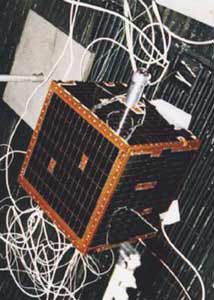
SEDSAT-1 is a U.S. amateur radio satellite built by students and developed at the University of Alabama in Huntsville (UAH).
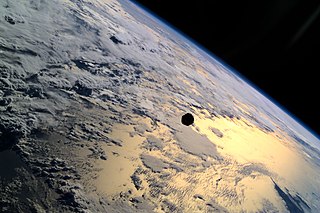
PANSAT was an amateur radio satellite. It was launched by Space Shuttle Discovery during the STS-95 mission as part of the third International Extreme Ultraviolet Hitchhiker (IEH-3) mission, on 30 October 1998 from Kennedy Space Center, Florida.
Eyesat-1 is an American experimental communications microsatellite with an store-dump payload. The mission of Eyesat-1 was experimental monitoring of mobile industrial equipment. Eyesat-1 has provided the National Oceanic and Atmospheric Administration in Silver Spring, Maryland, with communication services to the South Pole. Eyesat-1 carries an FM repeater for Amateur Radio Research and Development Corporation (AMRAD) called AMRAD OSCAR 27 or OSCAR 27.
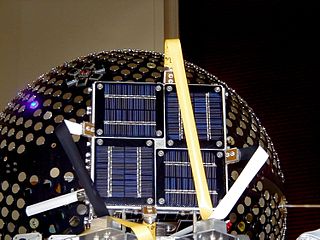
OSCAR 44 is an American amateur radio satellite for packet radio. It was built at the U.S. Naval Academy.
Orbiting Picosat Automatic Launcher is an American technology testing and amateur radio satellite that was developed by students at the Space Systems Development Laboratory at Stanford University in Palo Alto, California. The aim was to test the feasibility of launching several picosatellites from one parent satellite. The satellite's secondary payloads are an accelerometer testbed and a magnetometer testbed, which will perform component characterization. The main satellite ejected 6 nanosatellites in orbit. The development started in 1995 and was completed in May 1999.

Starshine 3 is one of five satellites in the Starshine project.
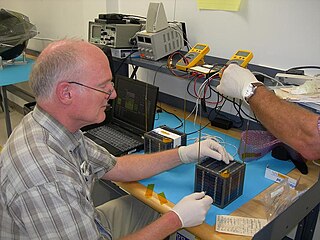
Radar Fence Transponder was an amateur radio satellite that was developed and built for training purposes at the United States Naval Academy. The 3 kg (6.6 lb) heavy RAFT had a cubic structure of 12.7 cm (5.0 in) edge length and therefore did not meet the Cubesat standard. Solar cells on all six sides of the satellite were used to supply energy. It had neither position control nor drive systems.
